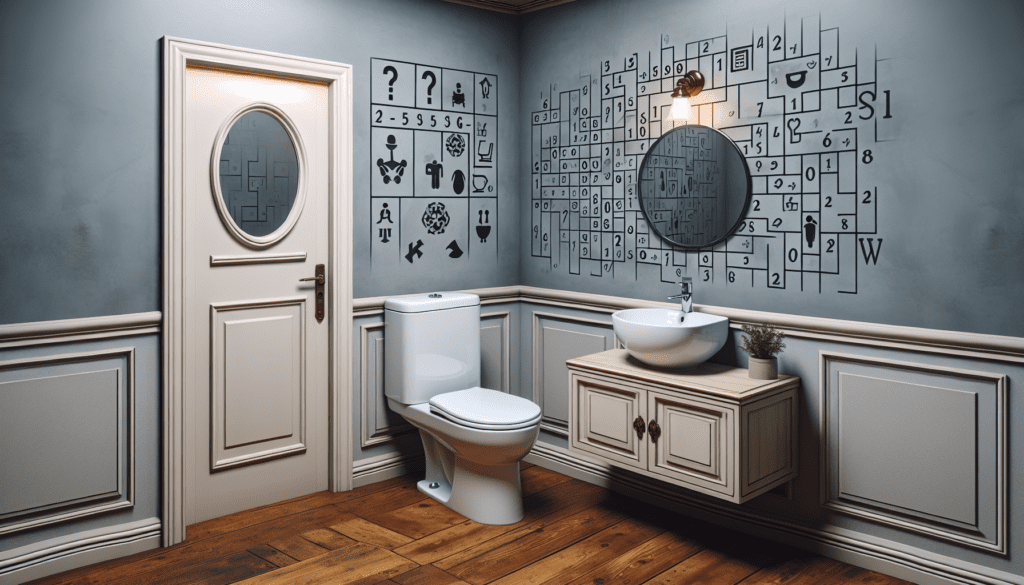Did you ever find yourself questioning the availability of toilets in escape rooms? Well, wonder no more! In this article, we explore the curious topic of whether or not there are restrooms conveniently tucked away within the confines of these thrilling puzzle-solving adventures. So, grab a snack and get ready to learn the answer to this pressing question!
Facilities in Escape Rooms
Escape rooms have become popular attractions for people looking for immersive and exhilarating experiences. These specially designed rooms offer a unique and challenging form of entertainment where participants are locked inside and must solve a series of puzzles and riddles to unlock the door and escape within a specified time limit. During these thrilling adventures, it is important to consider the facilities and amenities provided to ensure a comfortable and enjoyable experience for all participants.
Purpose of Escape Rooms
Escape rooms are designed to provide an exciting and immersive experience for individuals and groups. They offer an opportunity for participants to test their problem-solving skills, engage in teamwork and communication, and experience a wide range of emotions. The main aim is to create a thrilling and mentally stimulating environment where participants feel a sense of accomplishment when they successfully solve the puzzles and escape.
Design and Themes
Escape rooms are meticulously designed to create a unique atmosphere and transport participants into a different world. The rooms are often themed and decorated to match the storyline or scenario, making the experience more immersive and realistic. From futuristic sci-fi settings to ancient Egyptian tombs, the design and themes of escape rooms play a crucial role in enhancing the overall experience and setting the stage for an unforgettable adventure.
Inclusion of Facilities
While the primary focus of escape rooms is on the puzzles and challenges, it is essential to consider the inclusion of certain facilities for the comfort and safety of participants. Although escape rooms may vary in terms of amenities provided, there are some common factors that can enhance the overall experience and ensure that participants feel comfortable throughout the adventure.
Escape Room Experiences
Engaging Puzzles
At the heart of every escape room experience are the engaging puzzles and riddles that participants must solve to progress. These puzzles come in various forms, including numerical codes, hidden objects, intricate patterns, and logical challenges. They are designed to test participants’ critical thinking skills, creativity, and ability to work under pressure. Engaging puzzles are key to creating an enjoyable and mentally stimulating experience that keeps participants fully immersed in the game.
Time Constraints
One of the defining characteristics of escape rooms is the element of time pressure. Participants are typically given a specified time limit, usually ranging from 60 to 90 minutes, to solve all the puzzles and successfully escape the room. This time constraint adds an extra layer of excitement and urgency to the experience, challenging participants to think quickly and make decisive decisions. The ticking clock creates a sense of adrenaline and heightens the overall intensity of the game.
Teamwork and Communication
Escape rooms are ideal for fostering teamwork and communication among participants. To successfully solve the puzzles, players must work together, share information, and delegate tasks to utilize everyone’s unique skills and strengths. Effective communication is crucial for coordinating efforts, exchanging ideas, and solving complex challenges. By encouraging teamwork and communication, escape rooms provide an excellent opportunity for friends, families, and colleagues to bond and develop stronger relationships.

Escape Room Challenges
Physical Obstacles
Escape rooms often incorporate physical obstacles that participants must overcome to progress in the game. These obstacles can range from locked doors to hidden compartments and secret passages. By introducing physical challenges, escape rooms create a more interactive and hands-on experience, pushing participants to explore their surroundings and think outside the box. Climbing, crawling, and manipulating objects are just some of the physical tasks participants may encounter, adding an extra layer of excitement and adventure to the game.
Mental Challenges
In addition to physical obstacles, escape rooms present a series of mental challenges that require participants to use their cognitive abilities and problem-solving skills. These challenges may involve deciphering codes, solving math problems, unraveling complex patterns, or unraveling mysteries. Mental challenges test participants’ ability to think critically, analyze information, and make logical connections. By stimulating the mind and challenging participants intellectually, escape rooms provide a mentally stimulating experience that keeps players engaged throughout the game.
Emotional Stress
Escape rooms can also subject participants to emotional stress as they work against the clock and face the pressure of solving challenging puzzles. The combination of time constraints, the uncertainty of success, and the immersive environment can evoke a range of emotions, including excitement, frustration, and exhilaration. Managing and controlling emotions is a vital component of successfully navigating through an escape room. Learning to stay calm under pressure and maintaining focus is essential for maintaining a positive and enjoyable experience.
Escape Room Environment
Immersive Setting
Escape rooms are known for their immersive settings, designed to transport participants into a different world or scenario. From intricate set designs to realistic props, the environment is carefully crafted to enhance the overall experience and make players feel fully immersed in the storyline. Whether it’s a haunted house, a spaceship, or a detective’s office, the immersive setting adds an extra layer of excitement and authenticity to the game, allowing participants to truly feel like they are part of the adventure.
Dim Lighting
To create a more mysterious and atmospheric environment, escape rooms often incorporate dim lighting. This deliberate choice of lighting helps to set the mood, adding an element of suspense and intrigue to the game. However, it is important to note that the lighting level is typically adjusted to ensure that participants can still see and interact with their surroundings effectively. While dim lighting may create a sense of challenge and excitement, escape rooms prioritize safety and ensure that participants can navigate the room comfortably.
Sound Effects
Sound effects play a significant role in immersing participants in the escape room experience. By carefully selecting and implementing appropriate sound effects, escape rooms enhance the overall atmosphere and heighten the sense of realism. From creaking doors to eerie background music, the sound effects help to create a more engaging and immersive environment. However, it is essential to strike the right balance to prevent overwhelming participants and ensure that the sounds contribute to the overall enjoyment of the game.

Amenities Provided
Safety Measures
The safety of participants is of utmost importance in escape rooms. Therefore, escape room facilities generally prioritize safety measures to prevent any accidents or injuries during the game. This may include regular maintenance and inspections of the rooms and equipment, ensuring that all props and structures are secure and stable. Fire safety precautions, such as the presence of fire extinguishers and smoke detectors, are also commonly implemented to ensure a safe environment for participants.
Emergency Exits
Escape rooms are required to have clearly marked emergency exits that are easily accessible in case of any unforeseen circumstances or emergencies. These exits are strategically placed and must comply with building and safety regulations. Participants should familiarize themselves with the location of the emergency exits before starting the game to ensure they are prepared in case of any emergency situations.
Intercom Systems
To maintain clear communication between the participants and the game master, escape rooms often provide intercom systems. These systems allow players to ask for hints or assistance when they are stuck on a puzzle or need clarification. The game master can provide guidance or additional information through the intercom, ensuring that participants have a smooth and enjoyable experience. Intercom systems also serve as a safety measure, allowing the game master to communicate important instructions or alerts if necessary.
Customer Comfort
Seating Arrangements
Escape rooms are primarily designed for participants to be on their feet, actively engaging with the puzzles and exploring their surroundings. However, it is not uncommon for escape room facilities to provide seating arrangements within the rooms. These seating areas serve as resting spots for participants who may need a break or prefer to observe the game from a different perspective. Seating arrangements also cater to individuals who may have physical limitations or mobility issues, ensuring that everyone can enjoy the experience comfortably.
Temperature Control
Escape rooms strive to maintain a comfortable temperature for participants throughout the game. The temperature inside the rooms is carefully regulated to ensure that it is neither too cold nor too hot. This is particularly important considering the potential physical exertion and the time participants spend in the room. Adequate temperature control contributes to the overall comfort and enjoyment of the participants, allowing them to fully focus on solving the puzzles without being distracted by extreme temperatures.
Access to Water
To ensure that participants stay hydrated throughout the game, escape rooms often provide access to water. Hydration is essential, especially during longer games or in rooms with higher levels of physical activity. Having access to water allows participants to take short breaks and refresh themselves, ensuring that they maintain their energy and concentration levels. It is always recommended to stay hydrated during escape room experiences to maximize comfort and overall performance.

Toilets in Escape Rooms
Absence of Toilets
Escape rooms are typically designed without toilet facilities within the game rooms themselves. The main reason for this is to maintain the immersive and time-sensitive nature of the experience. Including a toilet would break the flow of the game and may disrupt the players’ engagement and focus. However, escape room facilities generally have restrooms available in common areas or adjacent to the game rooms for participants to use before or after the game.
Preparations before Entering
To ensure that participants have a seamless experience without interruptions, it is recommended to make necessary preparations before entering the escape room. This includes visiting the restroom, as mentioned earlier, to minimize the need for breaks during the game. Taking care of personal needs and ensuring comfort before starting the game allows players to fully immerse themselves in the experience without any unnecessary distractions or disruptions.
Breaks and Options
Although escape rooms do not typically have toilet facilities within the game rooms, participants can request short breaks if needed. Most escape room facilities are understanding and accommodating, allowing individuals or groups to briefly exit the room for personal needs. However, it is important to note that taking breaks may impact the overall gameplay and potentially disrupt the flow of the experience. It is advisable to communicate with the game master beforehand to discuss any specific needs or concerns regarding breaks.
Pre-Game Preparations
Bathroom Visits
Before embarking on the escape room adventure, it is always a good idea to make a visit to the restroom. This allows participants to start the game with an empty bladder, minimizing the need for frequent breaks during the experience. By taking care of this basic need beforehand, players can fully focus on the game and avoid any unnecessary distractions or disruptions that may arise due to bodily needs.
Hydration
Staying hydrated is vital for maintaining focus, concentration, and overall well-being during the escape room experience. It is recommended to drink an adequate amount of water before starting the game to ensure that participants are adequately hydrated. Hydration not only promotes comfort but also supports cognitive function, helping individuals to think clearly and effectively solve the puzzles. Bringing a water bottle along is also a good idea to have easy access to water during breaks if needed.
Emptying Pockets
Before entering the escape room, it is advisable to empty pockets of any unnecessary items or personal belongings that may hinder player movement or become a distraction. Carrying excessive items can make it difficult to navigate through the room or manipulate objects effectively. By emptying pockets of non-essential items, participants can ensure a smoother and more enjoyable experience, allowing them to fully engage with the puzzles and challenges without any unnecessary hindrances.

Escape Room Etiquette
Importance of Not Leaving
Escape rooms are designed to simulate challenging and immersive scenarios that require participants to remain fully engaged throughout the game. It is essential to respect the experience and avoid leaving the room once the game has started, as it can disrupt the flow and potentially spoil the fun for other participants. Exiting the room during the game may also violate the rules of the facility or interfere with the safety measures in place.
Alternative Solutions
When faced with difficult puzzles or challenges, it is crucial to think outside the box and explore alternative solutions. Escape rooms are designed to be mentally stimulating and require participants to think creatively and critically. If a particular approach or idea does not work, it is important to remain open-minded and flexible, considering other possibilities and solutions. Embracing alternative solutions enhances the overall experience and helps to fully appreciate the complexity and ingenuity of the puzzles presented.
Respecting the Experience
Respecting the escape room experience involves following the rules and guidelines provided by the facility, as well as treating the game master and fellow participants with courtesy and respect. It is important to listen to instructions carefully, avoid excessive noise or distractions, and refrain from damaging or mishandling any props or equipment within the room. Respecting the experience ensures a positive atmosphere and allows everyone involved to fully engage and enjoy the adventure.
Enforcement of Rules
Monitoring by Staff
Escape rooms are typically monitored by trained staff members or game masters who oversee the gameplay and ensure that participants adhere to the rules and guidelines. The staff members are responsible for providing hints or assistance when requested and ensuring a safe and fair experience for all participants. Regular monitoring by staff helps to maintain the integrity of the game and addresses any issues or concerns promptly.
Discouraging Interruptions
To ensure the smooth operation of the escape room experience, staff members discourage interruptions or distractions that may disrupt the gameplay. This includes discouraging the use of mobile phones, excessive noise, or any behavior that detracts from the immersive environment and the participants’ focus. By creating a distraction-free environment, escape room facilities prioritize the quality of the experience and allow participants to fully immerse themselves in the game.
Clear Instructions Given
To ensure that participants have a clear understanding of the rules and expectations, escape room facilities provide clear instructions at the beginning of each game. The instructions typically cover basic guidelines, safety precautions, and any specific rules or limitations that apply to the particular room or scenario. By providing clear instructions, escape room facilities contribute to the overall enjoyment of the experience while ensuring that participants are fully informed and prepared to embark on their adventure.
In conclusion, escape rooms offer a thrilling and immersive experience that challenges participants’ problem-solving skills, teamwork, and communication. These facilities prioritize creating an engaging and enjoyable environment by incorporating engaging puzzles, time constraints, and immersive settings. While the absence of toilets within the game rooms is common, escape room facilities generally provide restrooms for participants’ convenience before or after the game. Pre-game preparations, such as visiting the restroom and staying hydrated, are recommended to ensure a more comfortable experience. Respecting the etiquette and rules of the escape room enhances the overall atmosphere and allows for maximum enjoyment. By offering amenities, prioritizing customer comfort, and enforcing rules, escape room facilities strive to provide an unforgettable and enjoyable adventure for all participants.

